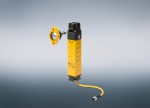The importance of safety interlocking
Published: 10 September, 2015
Alex Baggott, business development associate at Fortress Interlocks, looks at the Importance of safety interlocking in the Waste and Recycling Industry.
A metal recycling firm was recently fined £35,000 by the HSE after a worker’s hands were severed while cutting metal strips on an industrial baler.
Industrial balers are used to compress recyclable material into stackable, manageable pieces before they are sent for reprocessing. This type of machinery should be extensively guarded and interlocked to ensure operators can only come into contact with the machine when the power has been isolated.
Following an HSE investigation the company in question was served an enforcement notice to cease the inherently unsafe process. The HSE found that the firm was unable to produce evidence that it had carried out a proper assessment of the risks involved in the use of a baler for cutting metal strips.
Although the employee had been taught how to operate the machine by ‘practical demonstration and supervision’, he had not seen or read the operating manual. The immediate cause of the accident was blamed on an inherently unsafe system of work, which was contrary to the manufacturer’s operating instructions and the safety instructions on the machine.
Waste and recycling – an inherently dangerous industry
Human error is always a possibility when operating dangerous machinery and it is the employer’s responsibility to guarantee the safety of its workers by installing adequate safety systems are in place.
Waste and recycling is a particularly high-risk industry. While it accounts for only about 0.5% of the employees in Britain, it accounts for 2.6% of reported injuries to employees, according to the HSE.
Ensuring compliance
In reality there is no reason for many of these injuries to keep occurring – the technology to safeguard workers on all machinery in waste recycling plant already exists. It is also mandatory for Machine manufacturers to comply with the Machinery Directive and other essential health and safety requirements.
One way of demonstrating compliance is by applying the harmonised standards of the. Directive.
In this case, a risk assessment by the metal recycling firm, complying with the requirements of the Provision and Use of Work Equipment Regulations 1998 (PUWER), should have identified safety procedures as being inadequate, with further safety equipment added complying with EN ISO 13849 and EN ISO 14119 standards.
Safety interlocking
One of the most effective ways to ensure worker safety in the waste and recycling sector is machine guarding. However, machine guarding alone isn’t enough to ensure safe working practices, as there is nothing to prevent workers from using designated access points to gain entry into live machinery. It is usually necessary to include safety interlocking into the process
Safety interlocks prevent access to powered machinery and stop inadvertent start-ups while personnel are inside a dangerous area. They do this by forcing operators to isolate the power before anyone gains access. Maximum protection is afforded by incorporating keys into an interlocking system – this forces workers to retain a personal safety key with them while working inside the machine, so power can only be restarted once all the keys have been returned to their original positions. In this way, operators control their own safety.
There is a common misconception that safety interlocking is an unnecessary expense, so some companies implement cheaper alternatives, such as a Lock Out/Tag Out (LO/TO) procedures.
While LO/TO, when properly implemented, provides a minimum level of protection, one of its weakness lies in the inevitable failure of workers to always follow instructions. LO/TO’s greatest weakness is therefore interlocking's greatest asset: a well-designed safety interlocking system forces operators to follow a pre-determined, undefeatable sequence which they cannot deviate from. This compensates for any possible worker error while successfully safeguarding against potential hazards.
While clearly requiring more investment than LO-TO, safety interlocking offers peace of mind to employers that their workers are safe. Any additional time and cost in the design process is likely to be significantly smaller than the potential financial burden associated with the risk of future litigation.
Added to that, electromechanical safety switches can be a very cost-effective solution that can be wired directly to guard doors, allowing isolation to occur at the point of entry. In addition, these safety gate switches are installed so that they can be easily monitored and not easily defeated.
Until we eliminate the ideology that safety is an unnecessary expense in the waste and recycling industry, easily avoidable industrial accidents will continue to happen.
For further information please visit: www.fortressinterlocks.com





 PILZ has announced it is adding PSENmlock to its range of safety switches. PSENmlock offers safety gate monitoring (also known as interlocking) and safe guard locking for the protection of personnel and processes to the highest levels up to PL e (of EN ISO 13849) in one device. It fully satisfies the requirements of the latest interlocking standard EN ISO 14119. Pilz says the slimline yet robust design and the many different installation options make PSENmlock both flexible to use and easy to install.
PILZ has announced it is adding PSENmlock to its range of safety switches. PSENmlock offers safety gate monitoring (also known as interlocking) and safe guard locking for the protection of personnel and processes to the highest levels up to PL e (of EN ISO 13849) in one device. It fully satisfies the requirements of the latest interlocking standard EN ISO 14119. Pilz says the slimline yet robust design and the many different installation options make PSENmlock both flexible to use and easy to install.
